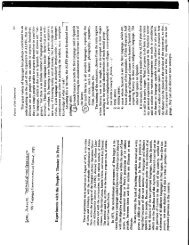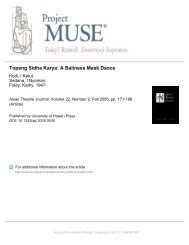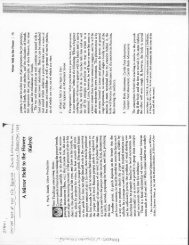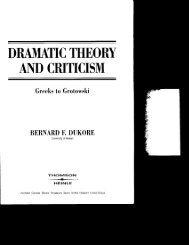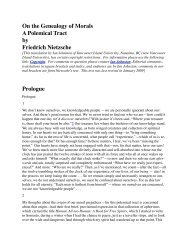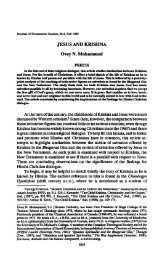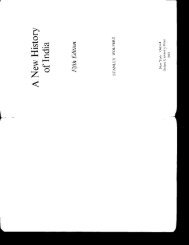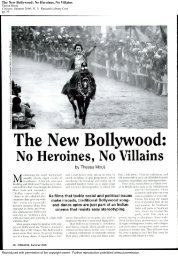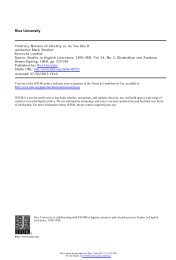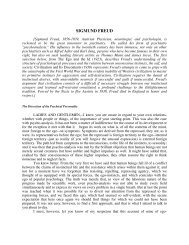Contemporary China - Yavanika
Contemporary China - Yavanika
Contemporary China - Yavanika
Create successful ePaper yourself
Turn your PDF publications into a flip-book with our unique Google optimized e-Paper software.
Ince<br />
reatre in <strong>China</strong> since 1949 are<br />
ama, newly arranged historifsHl-/u),<br />
spoken drama (huaju),<br />
Lnce drama {wzlu) and ballet.<br />
regional styles of traditional<br />
ained in the sections on inpernt<br />
is always from the distant<br />
stage properties are sinple,<br />
,ut costumes and makeup ale<br />
ms, posture and body move-<br />
:vening's entertainment will<br />
:e or four short items. Reform<br />
: removed certain items and<br />
the fbrm least affected by the<br />
arranged historical dramas'<br />
)st aspects of style, but as the<br />
reated by contemporary writn<br />
addition, scores of amateur<br />
petry tloupes perpetuate vanrns<br />
of puppet play (kuilei xi),<br />
i), and rod-puppet play lzhongle.<br />
:d forms, the most inportant<br />
iil). Only of this form car-r it be<br />
rat most items are set in the<br />
i949. The best representative<br />
tural Revolution was Lao SHl.<br />
: 1980s showed inventiveness<br />
I the most outside, mainly<br />
Social conmentary remained<br />
'ant-garde playr,vrights, propaoured<br />
by the CCP became less<br />
more and more subdued.<br />
minisn are hallmarks of conaywrights<br />
such as Bai Fengxi<br />
ave experimented with tech-<br />
, for example, variation in the<br />
of stage{ighting to show emocal<br />
atmospheres or qualities.<br />
e PRC normally use elaborate<br />
)perties and in urban theatres<br />
wn to mark beginning, end or<br />
rer, since 1982, a few plays<br />
nely simple stage properties,<br />
)ry and the curtain altogether.<br />
Ld postures are realistic, not<br />
nal nusic drama. But whereas<br />
r propaganda content tended<br />
cters through rather stilted,<br />
even stereotypical, movements and postures, natural<br />
style became morc popular in the 1980s to portray<br />
characters wl.ro themselves confomt less to<br />
images laid down as good, mediocre or bad by the<br />
CCP.<br />
The introduction ofWestern ballet is due principally<br />
to Soviet influence. Before 1966, ballet meant<br />
mainly items ol' clessicul Europern rcpcrloile,<br />
especially Swan Lake. The 'model' dlamas of Jiang<br />
Qng included nvo ballets: The White-Haired Girl and<br />
The Red Detachment 0J Wlmen lllongsc niangzi jun).<br />
Since 1976, these items have disappeared as ballets<br />
and classical works have returned. At the same<br />
time, Chinese artists are rnaking vcry tentative<br />
steps towards creating their own national ballet,<br />
including conposing new works and training<br />
ballet dancers. However, no high priority is given<br />
to this foln, and it is most unlikely ever to gain<br />
great popularity in <strong>China</strong> outside a small urban<br />
intellectual elite.<br />
lllustrative pieces<br />
0f all newly arranged historical dranas, none is<br />
more famous than The \4ftite Sndke \Baishe zhuan).<br />
0riginally a folk story about a white snake that<br />
turns into a beautiful wolnan, it underwent<br />
numerous adaptations, including a kunqu version<br />
by an anonymous playwright in the 18th century.<br />
Tian Han, one of the PRC's n-rost fanous dramatists,<br />
adapted it as a Beijing opera, completing the<br />
work in 1953. A monk in the kunqu is a positive<br />
character who succeeds in curbing the power of<br />
the wicked snake, but Tian Han has changed the<br />
characterization to present him as evil, the snake<br />
tumed woman as positive. Even though an element<br />
of magic is preserved, the iten thus advocates<br />
a positive role for women.<br />
The theme of patliotism supplements advocacy<br />
of equality for women in Women G enerals oJ the Yang<br />
Family \Yangmen nitjiang,), arranged as a Beijing<br />
opera in 1960 by Lti Ruiming on the basis of a late-<br />
Ming novel and a Yangzhon music drarna entitlcd<br />
CentenarianTakes Command (Baisui guashuar). Like all<br />
others on traditional the mes, this itern was banned<br />
during the Cultural Revolution. However it was<br />
revived in 1978. lt is set in the 11 th century. A centenarian<br />
dowager surnamed Yang persuades the<br />
women of her family to resist lru eneury aggrcssing<br />
from the north, and their forces win the final<br />
victory.<br />
Onc regional drana on a modern theme is The<br />
SLory of the Red Lantern lHongdeng ji), which features<br />
threc generations of Comnunist heroes and their<br />
stluggle against a Japanese general during the War'<br />
of Resistance against .|apan. The replesentatives of<br />
the two elder generatious are killed by thc gener-al,<br />
but the youngest lives to fight victoliously against<br />
hin. The item was adapted into a Bcijing opela by<br />
the play.rvlight-director Aiia (1907-95) and performcd<br />
at the 1964 Festival of Beijing Opera on<br />
Contenporary Thcmes. It was taken over byJiang<br />
Qing and recognized as one of her model dramas<br />
from 1970 on. The characterization was made<br />
starker to enphasize the class struggle; Western<br />
instrllnents were added to the acconpanying<br />
orchcstra and the music made more staccato to<br />
express the heroism of the ConlDunists better. The<br />
item was revived in the festival ofDecernber 1990<br />
and January 1991 to mark the 200th anniversary of<br />
the entry of thc Anhui corlpanies into BeUing.<br />
That this was not a sign ofa Cultural Revolutionary<br />
revival was demonstrated by the fact that the fbrm<br />
chosen was Ajia's, withJiang Qing bcing accused of<br />
having seized<br />
the item through an act ofrobbery.<br />
In the 1980s several spokcn dranas and newly<br />
arranged histolical music dramas appeared on the<br />
subject ofLi Shin-rin, one of<strong>China</strong>'s greatcst cmperors<br />
(r.626-49). He was the second ruler ofthe Tang<br />
dynasfy and held the imperial title ofTaizong, and<br />
so is known also as Tang Taizong. One of the music<br />
dranas is the Beijing opera Tant Tr:izcrn.g, arranged<br />
by Li Lun. It deals with Li Shimin's success in winning<br />
over a Turkish invader through mediation<br />
and popular support, not fbrce, thus securing<br />
national unity. The incident which fbrms the core<br />
ofthe drama is historical, but the characterization<br />
and plot are adapted to advocate political lessons<br />
appropriate to the prcsent. An item to be prenriered<br />
after the 1989 crisis was PaLnting Draglns<br />
and Filling in Eyes lHudong dianling) by Sun Yuexia<br />
and others. Set in 627 it portrays Li Shirnin as a<br />
kind of 'people's emperor' and an example for the<br />
Chinese nation and concerns his search for good<br />
officials and suppression of cormption. In the<br />
1980s the best writer of newly an-anged historical<br />
music drama was probably Wrr Mrrvcrun.<br />
More modeln national heroes portrayed on the<br />
stage since the late 1970s are revolutionaries such<br />
as Mao Zedong and Zhou Enlai. In 1981, the 70th<br />
anniversary of the overthrow of the last dynasty by<br />
43



